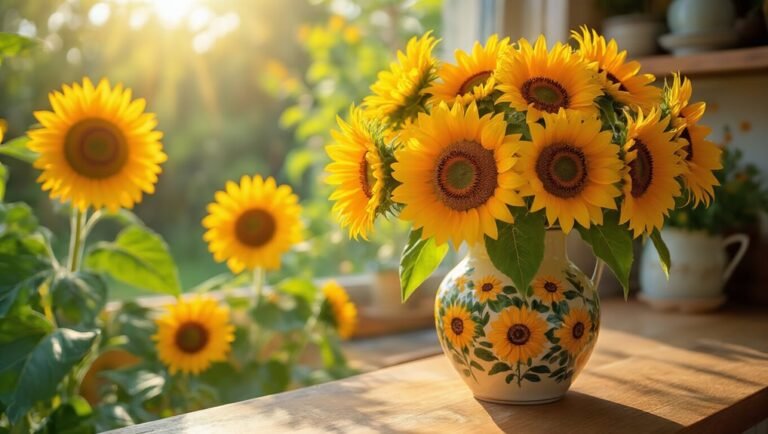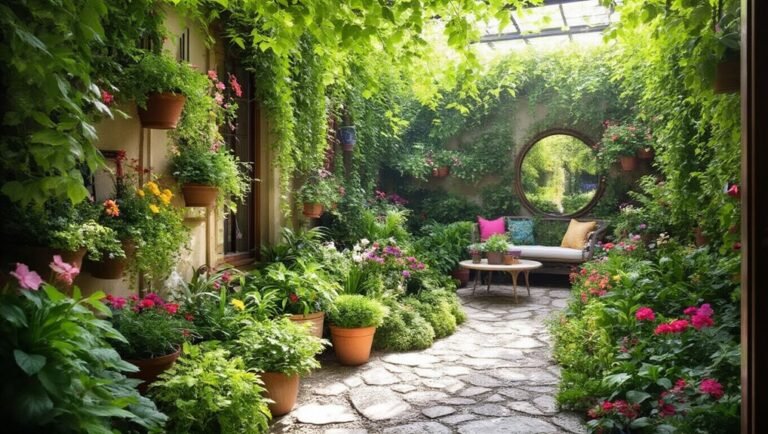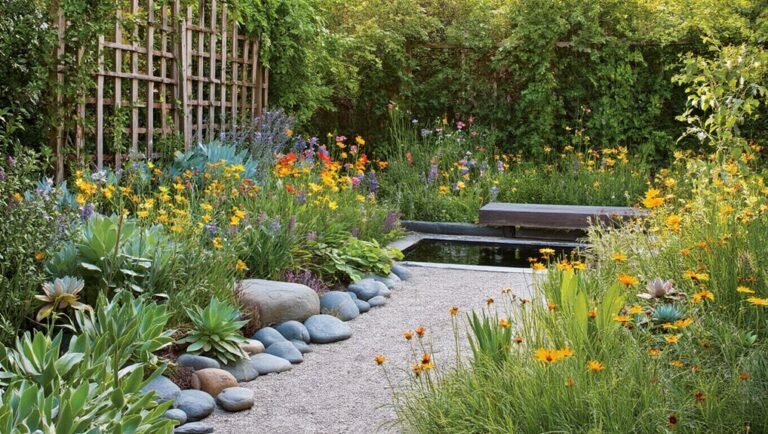Starting a flower garden is fun and rewarding! Choose flowers that suit your climate and soil type, like marigolds and zinnias, which are easy to grow. Plan a simple layout, mixing heights and colors for visual interest. Plant in spring after the last frost and use organic fertilizers for healthy blooms. Don’t forget about companion planting to keep pests at bay. If you’re eager to learn more tips and tricks, keep exploring!
Key Takeaways
- Choose easy-to-grow flowers like marigolds and zinnias that require minimal care and provide vibrant blooms throughout the season.
- Start with simple layouts, such as straight rows or circular designs, to create a clean and organized garden.
- Consider your local climate and soil type when selecting flowers to ensure they thrive in your garden.
- Plant a mix of perennials and annuals for continuous blooms and visual interest throughout the growing season.
- Regularly maintain your garden by deadheading spent flowers and checking for pests to keep plants healthy and attractive.
Choosing the Right Flowers for Your Garden
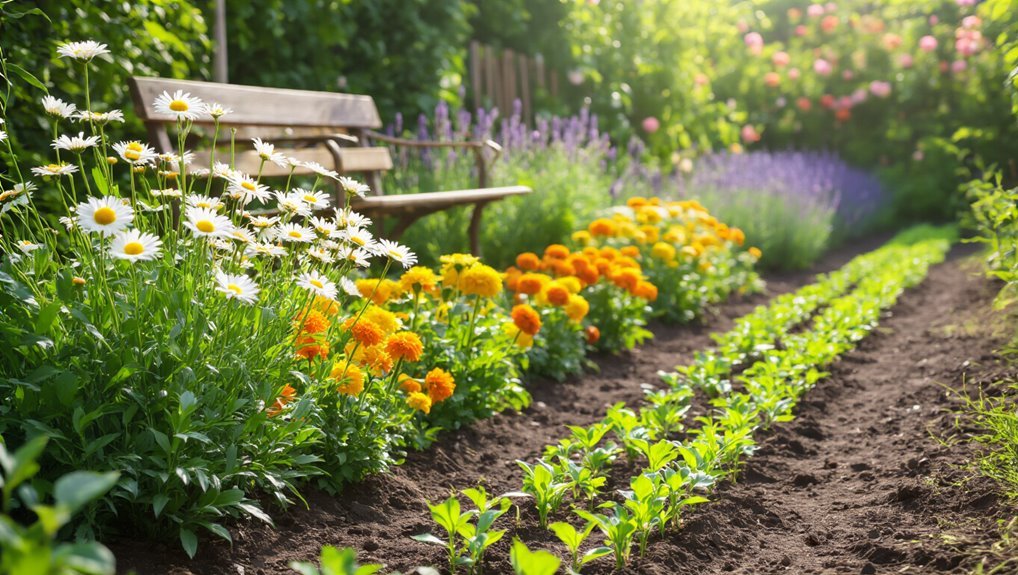
How do you choose the right flowers for your garden? Start by considering your climate and soil type. Some flowers thrive in sunny spots, while others prefer shade. Check your hardiness zone to find plants suited for your area. To keep track of the varieties you plant, consider using essential plant markers for easy identification and organization in your garden.
Next, think about the colors and styles you envision. Do you want vibrant blooms or soft pastels? Mixing perennials and annuals can create continuous color throughout the seasons.
Don’t forget about the maintenance level; some flowers require more care than others. Lastly, consider the height and spread of each plant to ensure they complement each other.
If you want to add beauty and flavor to your garden, consider planting edible flower seeds that can be used in both culinary dishes and floral displays.
Simple Flower Garden Layouts
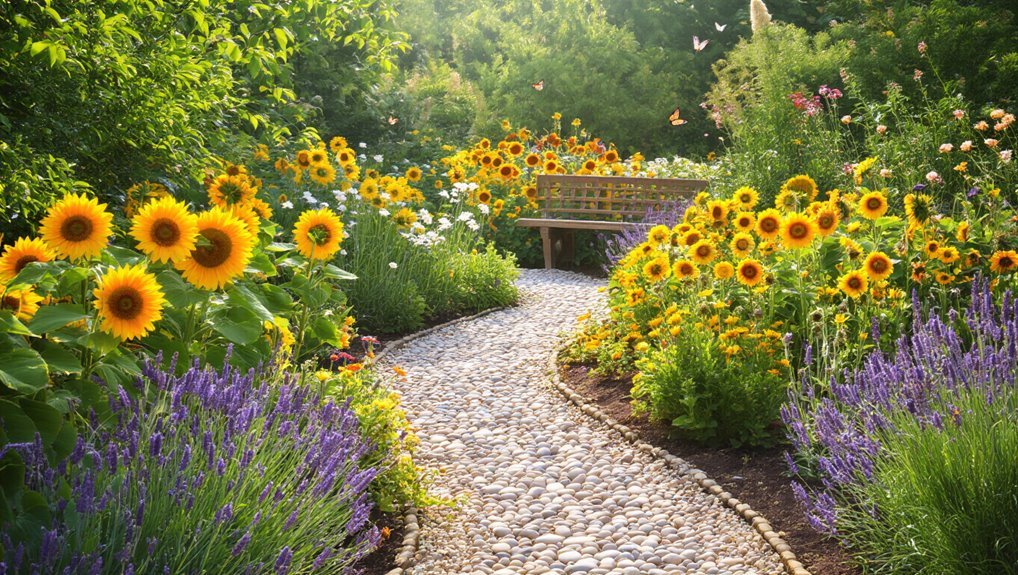
Once you’ve chosen the right flowers for your garden, it’s time to think about how to arrange them. Start with a simple layout, like a straight row or a curved border, to create a clean look.
You can also opt for a circular design, placing taller flowers in the center and shorter ones around the edges for a tiered effect. If you have limited space, try using containers or raised beds to maximize your planting area. Before you begin planting, it’s helpful to use seed starting kits to give your flowers a healthy head start indoors.
Group flowers with similar colors together for a vibrant display, or mix them for a more eclectic feel. Don’t forget to consider bloom times, ensuring your garden remains colorful throughout the season.
With these simple layouts, you’ll create a stunning flower garden that’s easy to maintain. Many gardeners find that using raised garden beds can elevate both the appearance and productivity of their flower gardens.
Best Time to Plant Flowers
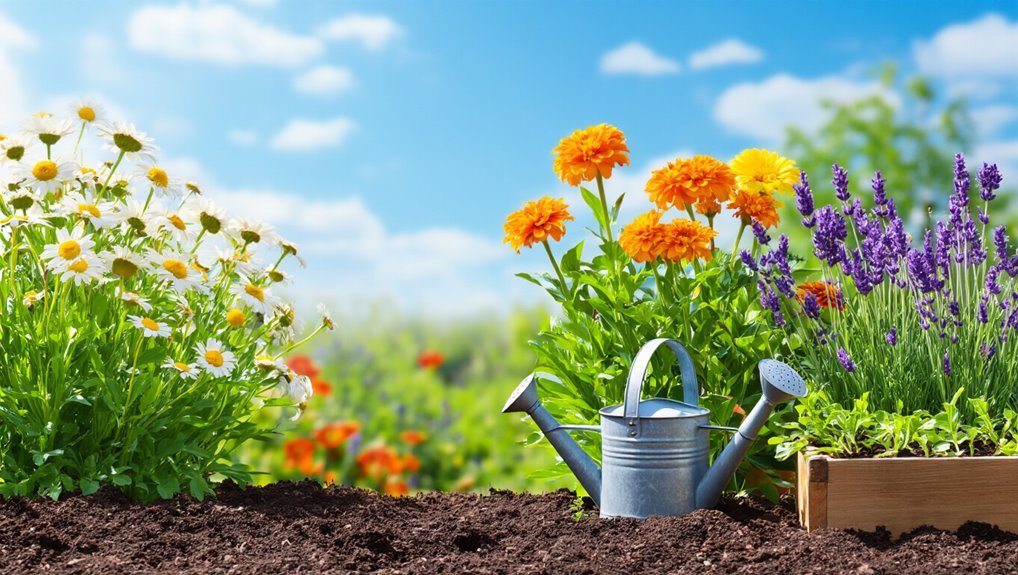
Choosing the best time to plant flowers is crucial for a thriving garden. Timing can vary based on your local climate and the type of flowers you want to grow.
Generally, spring is the ideal season for most annuals and perennials, as the soil warms up and frost danger decreases. If you’re in a warmer region, you might start planting as early as February. Using quality garden soil can help ensure your plants establish strong roots and grow vigorously during this period.
For fall bloomers, aim to plant in late summer to give them time to establish roots before winter. Always check the last frost date in your area to avoid planting too early.
For even more precise timing, consult planting guides or calendars designed for your region, as they provide detailed recommendations tailored to local conditions.
Easy-to-Grow Annuals and Perennials
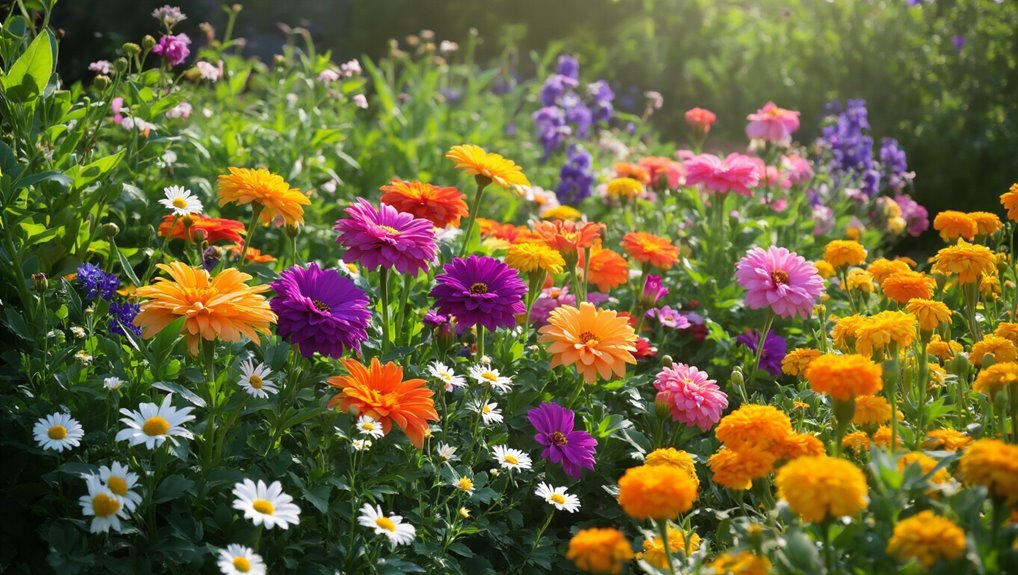
If you’re new to gardening and want to start with flowers that thrive with minimal effort, focusing on easy-to-grow annuals and perennials is a smart choice.
Annuals like marigolds, zinnias, and petunias bloom all season, adding vibrant color without the need for much care. They’re perfect for beginners since they quickly fill your garden with life. For even healthier growth, consider using plant food to supply essential nutrients throughout the blooming period.
On the other hand, perennials such as echinacea, daylilies, and black-eyed Susans come back year after year. Once established, they require little maintenance, making them a reliable choice.
Both types adapt well to various conditions, so you can find success even if you’re not an expert. By choosing these flowers, you’ll create a beautiful garden with minimal stress and effort.
For gardeners looking to further minimize maintenance, consider using self-watering planters to keep your flowers hydrated with less effort throughout the growing season.
Companion Planting for a Thriving Garden
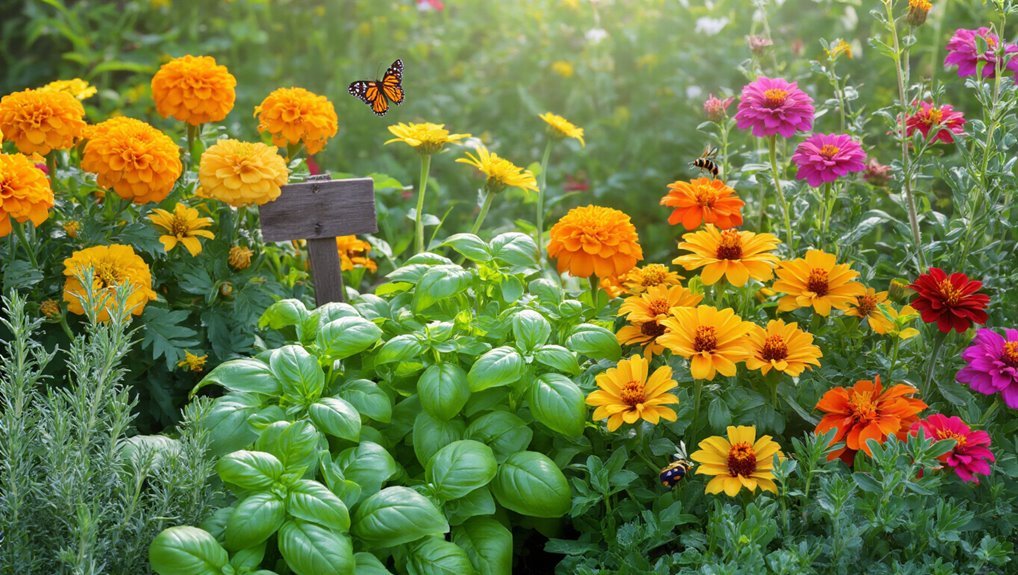
While you might think of planting flowers in isolation, companion planting can significantly enhance your garden’s health and beauty. By pairing certain plants, you can create a thriving ecosystem. For instance, marigolds repel pests like aphids and nematodes, making them an excellent companion for your vegetables and flowers. Nasturtiums attract beneficial insects, while also deterring harmful ones.
Additionally, planting daisies near your roses can boost their growth and color vibrancy. Many gardeners also benefit from using Organic Pest Control Solutions to address pest problems naturally. Don’t forget about spacing; ensure companions have enough room to grow without competing for nutrients.
As you select your plants, research their compatibility to maximize the benefits. For a natural way to keep pests at bay, consider adding insect repellent plants like citronella to your garden. With companion planting, you’ll cultivate a vibrant, flourishing garden you can be proud of.
Tips for Soil Preparation and Fertilization
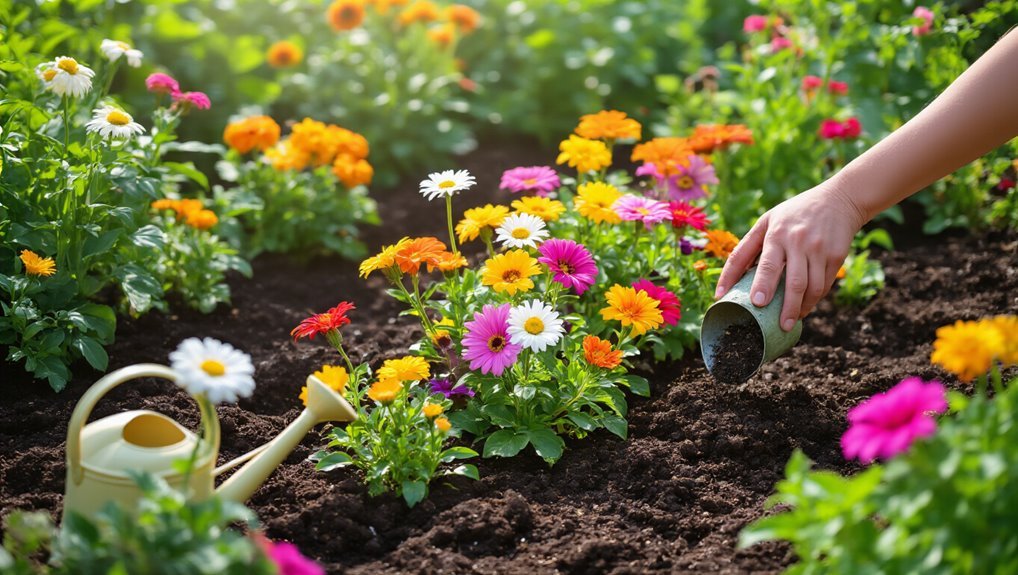
Healthy companion plants thrive in well-prepared soil, so starting with the right foundation is key to a successful flower garden.
Begin by testing your soil’s pH and nutrient levels. Most flowers prefer slightly acidic to neutral pH. Using organic mulching materials such as straw is also recommended for maintaining soil health and enhancing garden productivity.
Next, enrich your soil with organic matter like compost or well-rotted manure, which boosts fertility and improves drainage.
Tilling the soil to a depth of at least 12 inches helps aerate it and breaks up compacted areas.
When it comes to fertilization, choose a balanced fertilizer or one tailored to your specific flowers.
Apply it according to package instructions, usually in early spring and again mid-season.
This will provide essential nutrients for your flowers to flourish and create a vibrant garden.
Additionally, using mulch in your garden helps conserve moisture, suppress weeds, and regulate soil temperature, making it an essential addition to your soil preparation routine.
Effective Watering Techniques
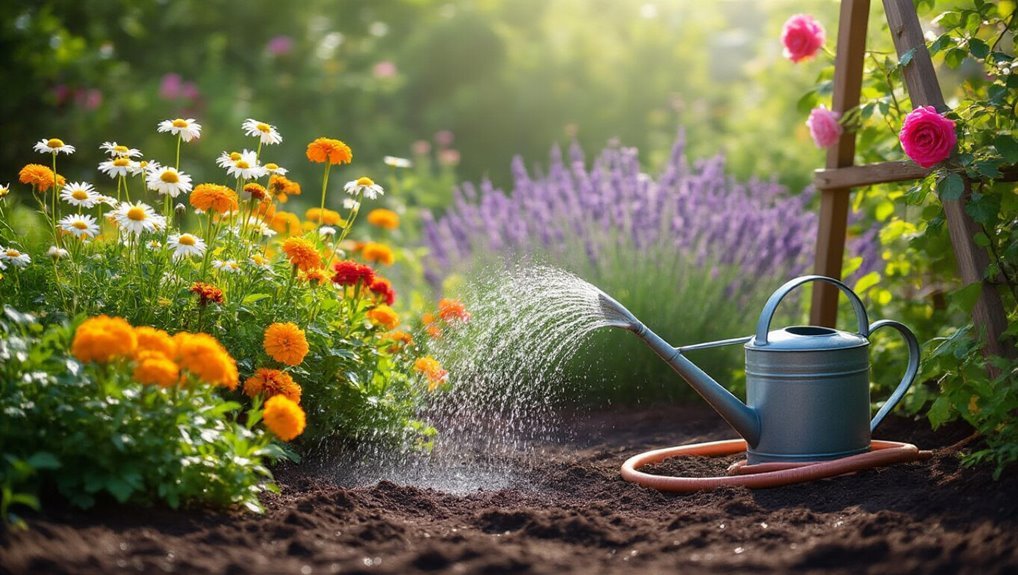
To ensure your flowers thrive, mastering effective watering techniques is essential.
Start by watering deeply but less frequently; this encourages roots to grow deeper into the soil. Early morning is the best time to water, as it allows plants to absorb moisture before the heat of the day. For gardeners seeking an easy solution, plant watering systems such as wicking systems can provide consistent moisture with minimal effort.
Use a soaker hose or drip irrigation to deliver water directly to the soil, minimizing evaporation and fungal diseases. Avoid overhead watering, which can lead to wet foliage and promote disease.
Always check the soil moisture first; if the top inch feels dry, it’s time to water. Lastly, consider the specific needs of your flowers, as different types may require varying amounts of water.
Keep an eye on weather conditions, adjusting your schedule accordingly. For optimal results, consider installing a drip irrigation system to maximize water efficiency and ensure your garden receives consistent moisture.
Maintaining Your Flower Garden Throughout the Season
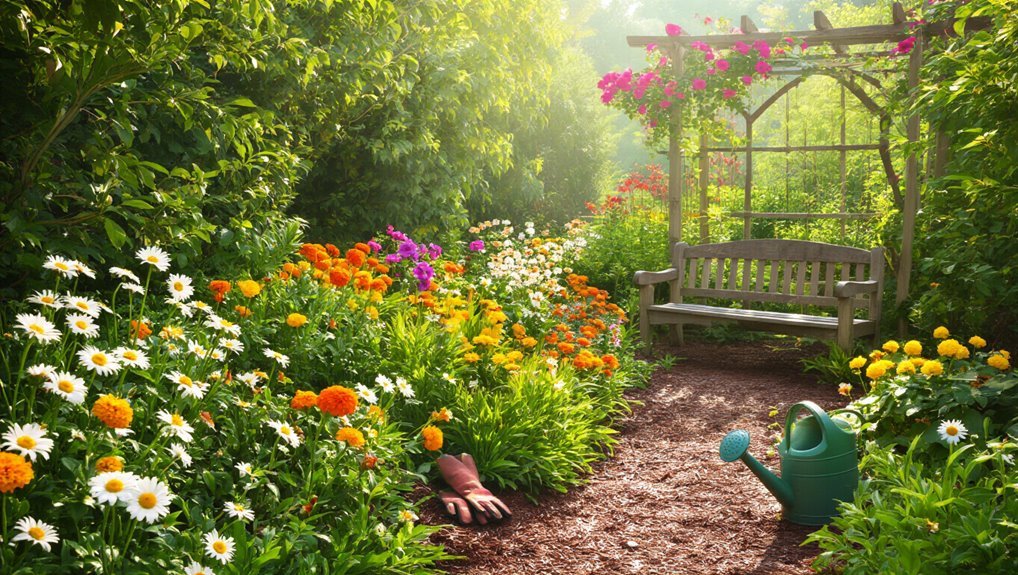
Watering techniques set the foundation for a thriving flower garden, but maintaining it throughout the season requires ongoing attention and care.
Regularly check your plants for pests and diseases; catching issues early can save your blooms. Deadheading spent flowers encourages growth and keeps your garden looking tidy. You can address pest problems by incorporating effective solutions for pest control to protect your plants from damage.
Don’t forget to mulch; it helps retain moisture and suppress weeds. As the season progresses, adjust your watering schedule based on rainfall and temperature changes.
Fertilize as needed to provide essential nutrients, especially during blooming periods. Lastly, keep an eye on plant spacing; overcrowded flowers may struggle for sunlight and airflow.
To help protect your flowers from pests and animals, consider using garden netting for an added layer of defense. With these practices, you’ll enjoy a vibrant and healthy flower garden all season long.
Frequently Asked Questions
How Much Sunlight Do Flowers Need Daily?
Most flowers need about six to eight hours of sunlight daily to thrive. If you’re growing them, ensure they’re positioned in a spot where they get plenty of bright, indirect light for optimal growth.
Can I Grow Flowers in Containers?
Yes, you can grow flowers in containers! Just choose the right pot size, ensure proper drainage, and select flowers suited for container gardening. With consistent watering and sunlight, your container flowers will thrive beautifully.
What Tools Do I Need for Flower Gardening?
Imagine the sun warming your back as you dig into rich, dark soil. You’ll need gloves, trowels, pruners, watering cans, and maybe a kneeling pad. These tools make your gardening journey easier and more enjoyable.
How Do I Prevent Pests in My Garden?
To prevent pests in your garden, you’ll want to maintain healthy plants, use barriers like row covers, introduce beneficial insects, and apply natural repellents. Regularly inspect your plants to catch any issues early.
When Should I Deadhead My Flowers?
“Out of sight, out of mind” doesn’t apply here! You should deadhead your flowers regularly, ideally after the blooms fade. This encourages new growth and prolongs flowering, keeping your garden vibrant and beautiful.
Conclusion
In conclusion, starting a flower garden can be incredibly rewarding. Did you know that spending just 20 minutes a day gardening can significantly reduce stress? By choosing the right flowers, planning your layout, and following our tips, you’ll create a vibrant space that not only beautifies your home but also nurtures your well-being. So grab your tools, dig into the soil, and watch your garden bloom into a stunning oasis that you’ll love tending to all season long!
